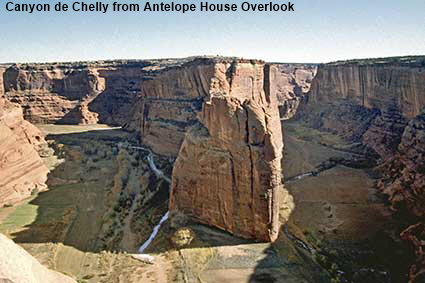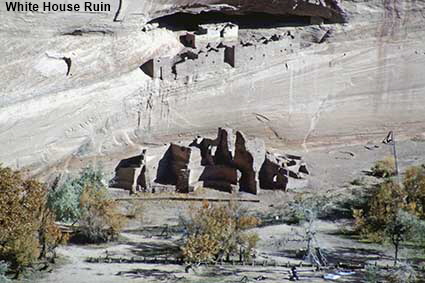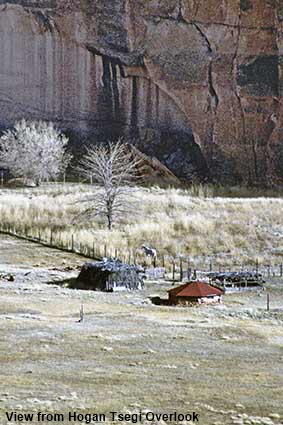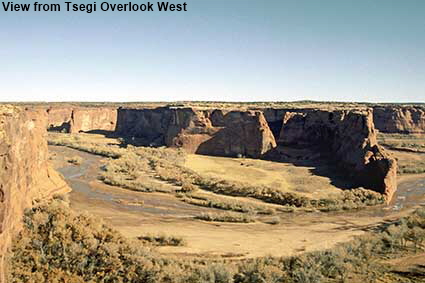View from Hogan Tsegi Overlook
The massive cliffs of the canyon make the buildings on the valley floor look tiny. The Navajo who farm the canyon still build Hogans although they are now used more for ceremonial purposes than as living quarters. The traditional Hogan had five sides and the door faced east. When a member of the resident family died they were buried under the floor and the Hogan was abandoned to become their tomb while the remaining family built a new one nearby. Modern Hogans as shown on the right of the picture tend to have six or eight sides.
White House Ruin
This is the one ruin that you can visit without a Navajo guide, but we stuck to the drive around the rim of the canyon and used a 400 mm lens to get close to the ruins. This ruin was named Casa Blanca (White House) in 1849 by Lt. James Simpson of the Corps of Topographical Engineers because a white plastered room was found in the upper part of the ruins during a survey. The White House is thought to have been built around 1040 AD with around 80 rooms.
Canyon de Chelly National Monument
Canyon de Chelly (pronounced ‘de Shay’) is called Tsegi by the Navajo. The Spanish corrupted this to Canyon de Chegui, but from the late 18th century it was called de Chelly albeit with inconsistent spelling. Scattered throughout the canyon can be found many Anasazi ruins. Although made a National Monument in 1931 the area is Navajo Tribal Trust Land with Navajo families still living in the canyon and farming there much as their ancestors did. The main way of viewing the canyon is from a drive around the rim. Hiking within the canyon is strictly controlled and in most cases requires a Navajo guide.
DLU050822
Canyon de Chelly from Antelope House Overlook
The National Monument is not a linear canyon like the Grand Canyon, but instead comprises a number of canyons branching from Canyon de Chelly which is the largest canyon. With cliffs around 250 metres (800 feet) high, the branching creates great headlands, as shown here between Canyon del Muerto on the left and the smaller Black Rock Canyon on the right.
View from Tsegi Overlook West
A view of the main Canyon de Chelly near to the canyon mouth where the cliffs are lower and a little less impressive than further up the canyons.
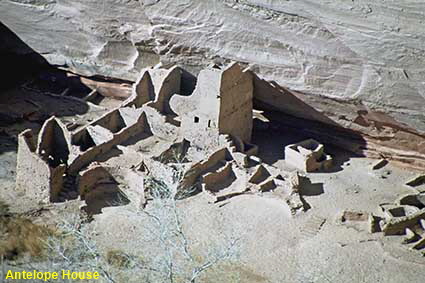
Click on Minimap to navigate
Home > US States > The Southwest > Arizona >


To move forwards or backwards through the Arizona trail click the arrows above, or select your next destination on the Minimap.

Antelope House
The Anasazi settlements in Canyon de Chelly were small compared to Chaco Canyon in neighbouring New Mexico. There is evidence that people were living on this site in the late 7th century AD. At its peak, it is estimated that Antelope House had over 90 rooms and at least 4 Kivas. The settlement was abandoned by 1260 AD possibly due to flooding as there is evidence that part of the settlement has been washed away. The Anasazi name for the settlement is unknown, so it has been named after 19th century Navajo rock paintings of antelope near to the ruins.

© Mike Elsden 1981 - 2025
The contents of this page may not be reproduced in full or in part without permission
